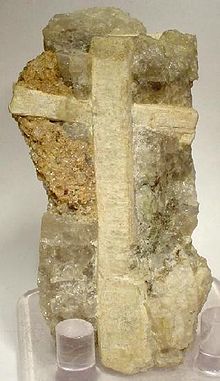| Meionite | |
|---|---|
 Meionite (scapolite) crystals (cross-shaped) in a quartz matrix, 7.2 × 4.0 × 3.0 cm. Worcester County, Massachusetts. Meionite (scapolite) crystals (cross-shaped) in a quartz matrix, 7.2 × 4.0 × 3.0 cm. Worcester County, Massachusetts. | |
| General | |
| Category | Tectosilicate Scapolite group |
| Formula (repeating unit) | Ca4Al6Si6O24CO3 |
| IMA symbol | Me |
| Strunz classification | 9.FB.15 |
| Crystal system | Tetragonal |
| Crystal class | Dipyramidal (4/m) (same H-M symbol) |
| Space group | I4/m |
| Unit cell | a = 12.179(1) Å, c = 7.571(1) Å, Z = 2 |
| Identification | |
| Color | Colorless, white, grey, pink, violet, blue, yellow, orange-brown, brown |
| Cleavage | Distinct/good on {100}{110} |
| Fracture | Irregular/uneven, conchoidal |
| Tenacity | Brittle |
| Mohs scale hardness | 5–6 |
| Luster | Vitreous, resinous, pearly |
| Streak | White |
| Diaphaneity | Transparent, opaque |
| Specific gravity | 2.74–2.78 |
| Optical properties | Uniaxial (−) |
| Refractive index | 1.556 to 1.600 |
| Birefringence | 0.024 to 0.037 |
| References | |
Meionite is a tectosilicate belonging to the scapolite group with the formula Ca4Al6Si6O24CO3. Some samples may also contain a sulfate group. It was first discovered in 1801 on Mt Somma, Vesuvius, Italy. It was named by Rene Just Haüy after μειωυ, the Greek word for less, in reference to the less acute pyramidal form as compared to vesuvianite.
As an end-member of the scapolite solid solution, meionite has the largest cell dimension and very high thermal stability at high pressures. This indicates that meionite is one of the primary minerals in deep seated basic or intermediate magmatic processes. Meionite also breaks down to grossularite + kyanite + quartz + calcite at high pressure, similar to the upper pressure limits of anorthite. This sets its occurrence to the crustal rocks.
References
- Warr, L.N. (2021). "IMA–CNMNC approved mineral symbols". Mineralogical Magazine. 85 (3): 291–320. Bibcode:2021MinM...85..291W. doi:10.1180/mgm.2021.43. S2CID 235729616.
- Mineralienatlas
- Mindat.org
- Webmineral.com
- Handbook of Mineralogy
- Teertstra, David K.; Sherriff, Barbara L. (1997-04-25). "Substitutional mechanisms, compositional trends and the end-member formulae of scapolite". Chemical Geology. 136 (3): 233–260. Bibcode:1997ChGeo.136..233T. doi:10.1016/S0009-2541(96)00146-5. ISSN 0009-2541.
- Eugster, Hans P.; Prostka, Harold J.; Appleman, Daniel E. (14 September 1962). "Unit-Cell Dimensions of Natural and Synthetic Scapolites". Science. 137 (3533): 853–854. doi:10.1126/science.137.3533.853. PMID 17787337. S2CID 2289057.
- Newton, Robert C.; Goldsmith, Julian R. (1975). "Stability of the scapolite meionite (3CaAl2Si2O2 · CaCO3) at high pressures and storage of CO2 in the deep crust". Contributions to Mineralogy and Petrology. 49 (1): 49–62. doi:10.1007/BF00371078. S2CID 129389988.
This article about a specific silicate mineral is a stub. You can help Misplaced Pages by expanding it. |